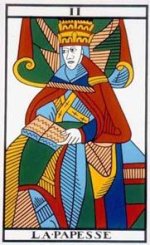catboxer
Marseilles Decks -- II La Papesse
A couple of historical analogues have been suggested as models for the Lady Pope. The (probably apocryphal) Pope Joan and a Guglielma of Bohemia, supposedly a Visconti relative of the late 13th century, are both discussed by Rachel Pollack on page 29 of her "Complete Illustrated Guide."
But the Lady Pope has, since her first appearance, become a high priestess, and I wonder whether she was a high priestess before she was a pope. What I mean is that the archetype of the wise, powerful woman, possessed of immense and mysterious power, is embedded deeply in both the human psyche and the human past. The first known religions were goddess religions, and the first real rulers of organized societies were priestesses. The image predates the tarot.
Consider this from Robert Graves, the great British historian, cultural anthropologist, and anti-Jungian:
"The whole of neolithic Europe, to judge from surviving artifacts and myths, had a remarkably homogeneous system of religous ideas, based on worship of the many-titled mother goddess, who was also known in Syria and Libya.
"Ancient Europe had no gods. The great goddess was regarded as immortal, changeless, and omnipotent; and the concept of fatherhood had not been introduced into religious thought. She took lovers, but for pleasure, not to provide her children with a father. Men feared, adored, and obeyed the matriarch.
"Not only the moon, but (to judge from Hemera of Greece and Grainne of Ireland) the sun, were the goddess's celestial symbols. In earlier Greek myth, however, the sun yields precedence to the moon -- which inspires the greater superstitious fear, does not grow dimmer as the year wanes, and is credited with the power to grant or deny water to the fields."
(note: Farmers in many parts of the world still plant according to the phases of the moon.)
"The tribal Nymph, it seems, chose an annual lover from her entourage of young men, a king to be sacrificed when the year ended; making him a symbol of fertility, rather than the object of her erotic pleasure. His sprinkled blood served to fructify trees, crops, and flocks, and his flesh was torn and eaten raw by the Queen's fellow-nymphs -- priestesses wearing the masks of bitches, mares, or sows."
When I look at this card I see a representation of immense but inscrutable power. The Lady Pope knows the unspeakable secrets of the subconscious; and since they're unspeakable, she never speaks. She is the terrifying power of the moon, and intuition personified.
Dave B
(Catboxer)
A couple of historical analogues have been suggested as models for the Lady Pope. The (probably apocryphal) Pope Joan and a Guglielma of Bohemia, supposedly a Visconti relative of the late 13th century, are both discussed by Rachel Pollack on page 29 of her "Complete Illustrated Guide."
But the Lady Pope has, since her first appearance, become a high priestess, and I wonder whether she was a high priestess before she was a pope. What I mean is that the archetype of the wise, powerful woman, possessed of immense and mysterious power, is embedded deeply in both the human psyche and the human past. The first known religions were goddess religions, and the first real rulers of organized societies were priestesses. The image predates the tarot.
Consider this from Robert Graves, the great British historian, cultural anthropologist, and anti-Jungian:
"The whole of neolithic Europe, to judge from surviving artifacts and myths, had a remarkably homogeneous system of religous ideas, based on worship of the many-titled mother goddess, who was also known in Syria and Libya.
"Ancient Europe had no gods. The great goddess was regarded as immortal, changeless, and omnipotent; and the concept of fatherhood had not been introduced into religious thought. She took lovers, but for pleasure, not to provide her children with a father. Men feared, adored, and obeyed the matriarch.
"Not only the moon, but (to judge from Hemera of Greece and Grainne of Ireland) the sun, were the goddess's celestial symbols. In earlier Greek myth, however, the sun yields precedence to the moon -- which inspires the greater superstitious fear, does not grow dimmer as the year wanes, and is credited with the power to grant or deny water to the fields."
(note: Farmers in many parts of the world still plant according to the phases of the moon.)
"The tribal Nymph, it seems, chose an annual lover from her entourage of young men, a king to be sacrificed when the year ended; making him a symbol of fertility, rather than the object of her erotic pleasure. His sprinkled blood served to fructify trees, crops, and flocks, and his flesh was torn and eaten raw by the Queen's fellow-nymphs -- priestesses wearing the masks of bitches, mares, or sows."
When I look at this card I see a representation of immense but inscrutable power. The Lady Pope knows the unspeakable secrets of the subconscious; and since they're unspeakable, she never speaks. She is the terrifying power of the moon, and intuition personified.
Dave B
(Catboxer)


